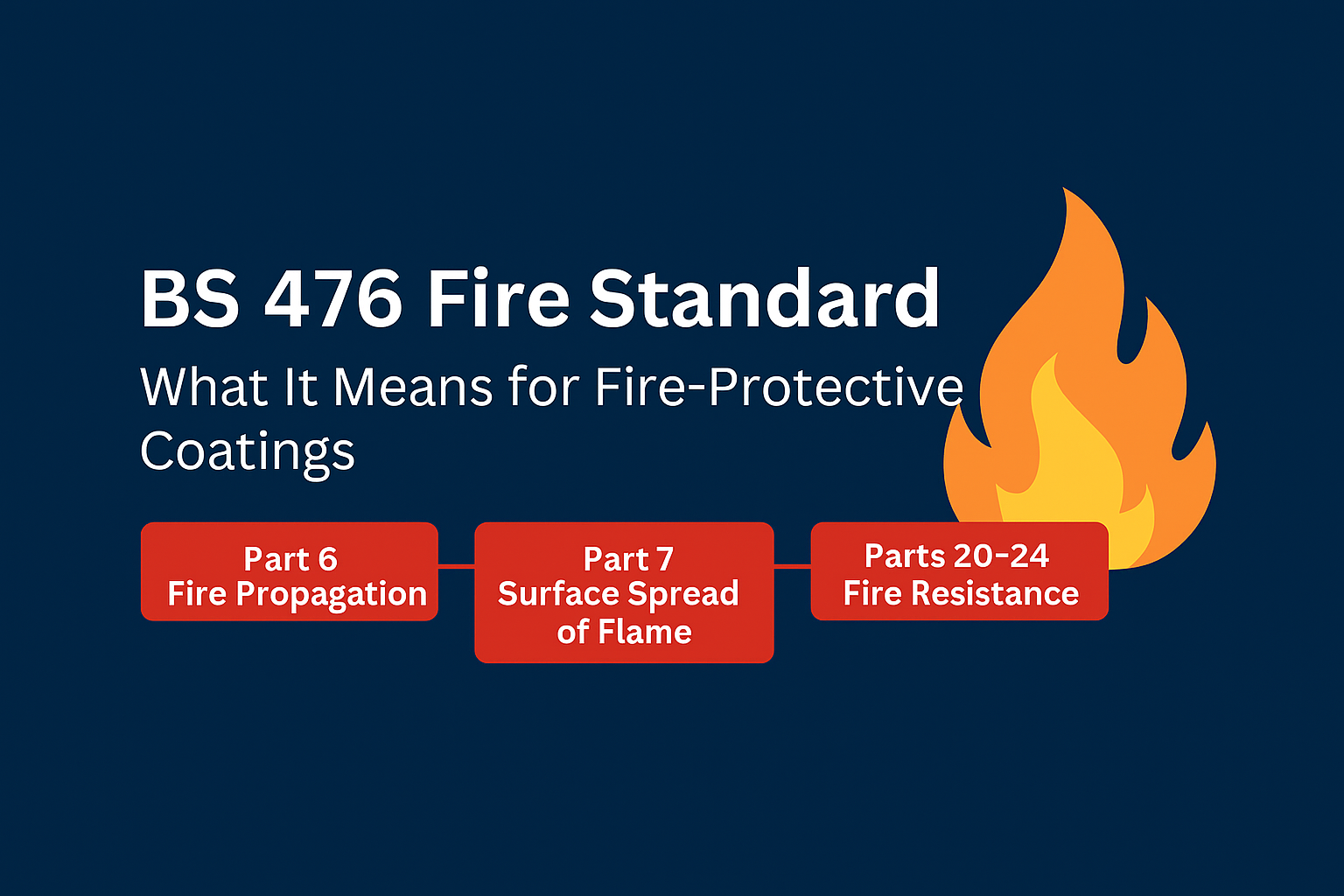Introduction
In fire safety, standards are not just paperwork — they are the measure of whether a material will protect lives and assets when a fire breaks out. One of the most widely recognized benchmarks in the world of passive fire protection is the BS 476 series, developed by the British Standards Institution (BSI).
For decades, BS 476 has been the go-to reference for testing the reaction to fire (how materials ignite and spread flames) and fire resistance (how long building elements can withstand fire). Although it has been replaced in the UK by EN 13501 (Euroclass system), BS 476 remains deeply embedded in India, the Middle East, and Asia, where it continues to be specified in government tenders, infrastructure projects, and private sector works.
For customers, consultants, and contractors, understanding what BS 476 means and what it does not mean is critical in separating genuine fire safety performance from misleading marketing claims.
What BS 476 Covers
The BS 476 series is a group of fire test standards that check two main things:
- How a material reacts to fire – Does it catch fire easily? Does it spread flames? Does it release heat?
- How long a structure can resist fire – Can a coated steel beam, duct, or wall survive in a furnace without collapsing or letting fire pass through?
Together, these tests give a full picture of fire safety performance.
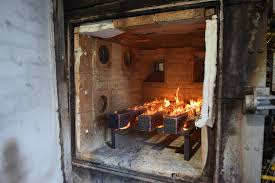
Main Parts of BS 476 and How They Are Tested
- Part 4 – Non-Combustibility
What it checks: Is the material truly non-combustible?
How it’s tested: A sample is placed in a furnace at ~750°C. If it ignites or releases too much heat, it fails. - Part 6 – Fire Propagation
What it checks: Does the material add fuel and make a fire grow?
How it’s tested: A sample is exposed to a heat source and small flame. The heat rise is measured and converted into a fire propagation index. The lower the number, the safer the product. - Part 7 – Surface Spread of Flame
What it checks: How quickly flames travel over the surface.
How it’s tested: A flame is applied at one end of a panel in a small tunnel furnace. The distance the flame travels is measured. Results are Class 1 (best) to Class 4 (worst). - Part 11 – Heat Emission
What it checks: How much heat a material gives off when exposed to high temperature.
How it’s tested: The material is heated by a radiant source, and heat released is measured. - Part 20 – Fire Resistance: General Principles
What it checks: The rules for testing walls, floors, ducts, and steel sections in a fire.
How it’s tested: A specimen is put inside a furnace that follows a standard fire curve (temperature rises with time). Performance is judged on:- Stability – does it collapse?
- Integrity – does fire or smoke pass through?
- Insulation – does heat transfer to the unexposed side?
- Part 21 – Loadbearing Elements (Structural Steel)
What it checks: How long beams and columns coated with fireproofing can carry load in fire.
How it’s tested: Steel members are loaded, then placed in a furnace. Time to failure (when steel exceeds safe temperature or collapses) is recorded — usually 30, 60, 90, or 120 minutes. - Part 22 – Non-Loadbearing Elements
What it checks: Fire performance of walls, partitions, floors, and ceilings that don’t carry load.
How it’s tested: Specimens are put in a furnace and checked for integrity and insulation over time. - Part 23 – Components of Construction
What it checks: Doors, shutters, glazing systems, or other building components.
How it’s tested: Full assemblies are furnace-tested for how long they block fire and heat. - Part 24 – Ventilation Ducts
What it checks: Can ducts resist fire and stop flames/smoke from spreading?
How it’s tested: Ducts are exposed in a furnace under two conditions:- Type A: Fire outside the duct.
- Type B: Fire inside the duct.
Ducts are pressurised, and performance is measured by stability, integrity, insulation for set durations (e.g., 120 minutes).
In simple terms:
- Parts 6 & 7 tell us how easily a surface catches and spreads flames.
- Parts 20–24 tell us how long a coated structure (steel, wall, duct, door) will survive in fire.
How BS 476 Testing Is Done
Fire testing under BS 476 is not theoretical — it is carried out in controlled laboratories under strict conditions. The goal is to simulate real fire scenarios and measure how materials or coated systems perform.
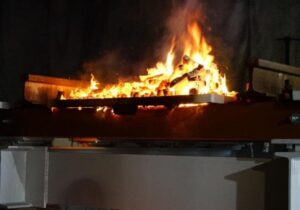
🔹 General Testing Process
- Sample Preparation
- Coated panels, steel sections, ducts, or assemblies are prepared according to the manufacturer’s system.
- Thickness, primer, and finish coats are applied exactly as they would be on-site.
- Mounting in Test Apparatus
- For surface tests (Parts 6 & 7), samples are fixed in small furnaces or test chambers.
- For fire resistance tests (Parts 20–24), large samples such as beams, walls, or ducts are mounted in a full-scale furnace.
- Fire Exposure
- A standard time–temperature curve (ISO 834) is followed in the furnace — temperature rises rapidly to ~945°C within 60 minutes.
- Surface flame tests use direct flame exposure and radiant heat sources to check ignition and spread.
- Observation & Measurement
- Part 6: Heat rise is recorded to calculate a fire propagation index.
- Part 7: Flame spread distance and speed are measured.
- Part 20–24: Furnace temperature, specimen deflection, cracks, collapse, smoke/flame leakage, and unexposed-side temperature rise are all monitored.
- Classification
- Reaction to fire → Rated as Class 1 to 4 (Part 7) or by index (Part 6).
- Fire resistance → Reported as minutes (30, 60, 90, 120, etc.) for Stability (R), Integrity (E), and Insulation (I).
- Results are documented in a fire test report issued by the accredited lab.
Credibility of BS 476
The strength of BS 476 lies not just in its history but in the fact that it has been the reference point for fire testing for over 50 years. Even today, it remains a trusted benchmark across many regions.
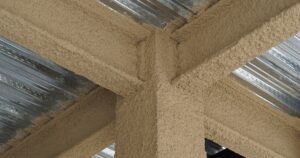
🔹 Why BS 476 Is Considered Credible
- Time-Tested Standard
- In use since the mid-20th century, BS 476 has shaped how fire safety is measured in construction worldwide.
- Independent Verification
- Tests are carried out in accredited laboratories such as Warringtonfire, UL, Intertek, BRE, or in India, CSIR-CBRI and NABL-approved labs. Reports from such bodies are legally and technically valid in tenders and approvals.
- Tender & Regulatory Acceptance
- Still referenced in CPWD, Metro Rail, Airport Authority, refinery, and defence tenders in India.
- Widely accepted in Middle East and Asia, especially for structural steel coatings, ducts, and fire barrier systems.
- Benchmark for Comparison
- Even though EN 13501 has replaced BS 476 in the UK and EU, many consultants still use BS 476 results as a baseline when reviewing fireproofing performance.
Bottom line: A coating tested under BS 476 provides documented, third-party proof that it will limit flame spread and protect structures for a defined period under fire conditions. This credibility is why it continues to appear in project specifications, even outside the UK where newer standards have taken over.
What BS 476 Does Not Mean
While BS 476 is a credible and widely accepted standard, it is often misunderstood or misused in marketing. To avoid confusion, it’s important to be clear about what this standard does not guarantee.
🔹 Common Misconceptions
- “Class 0 means fireproof” – False
- “Class 0” was a UK regulatory category, not a standalone test.
- It combined results from Part 6 (Fire Propagation) and Part 7 (Surface Spread of Flame).
- A Class 0 rating means limited flame spread, not that the product is completely fireproof.
- “One BS 476 test covers everything” – False
- Each part of BS 476 applies to a specific element:
- Parts 6 & 7 → Surface ignition and flame spread.
- Parts 20–24 → Fire resistance of steel, ducts, walls, or doors.
- A coating tested to Part 7 cannot claim “2-hour fire resistance” under Part 21 unless separately tested.
- Each part of BS 476 applies to a specific element:
- “BS 476 approval = global acceptance” – False
- In the UK and EU, BS 476 has been replaced by EN 13501, and Class 0 is no longer accepted.
- In the US, only ASTM/UL standards are recognized.
- BS 476 is still credible in India, Middle East, and Asia, but always check the local code or tender requirements.
- “Any test report is valid” – False
- Only reports from accredited laboratories (e.g., CSIR-CBRI, NABL-approved labs, Warringtonfire, UL, Intertek) are valid.
- Private or in-house test data without accreditation hold no approval weight in government or international tenders.
Key Message for Customers:
BS 476 tells you how a coating or system behaves in fire under a controlled test, but it does not automatically mean:
- The product is “fireproof forever.”
- That one test result covers every structure, thickness, or environment.
- That it meets regulatory requirements in all countries.
BS 476 in Context: Other Fire Standards You Should Know
While BS 476 is one of the most established standards, it is not the only way fire safety is measured. Different regions follow different benchmarks, and knowing them helps customers and consultants choose the right coating for their project.
🔹 EN 13501 (Europe – Euroclass System)
- Replaced BS 476 in the UK and EU.
- Reaction to Fire: Materials are rated from A1 (non-combustible) down to F (easily flammable), with additional smoke and droplet ratings (s1–s3, d0–d2).
- Fire Resistance: Rated as EI/REI (Integrity, Insulation, Loadbearing) for specific durations.
- Mandatory across all EU projects — Class 0 under BS 476 is no longer accepted.
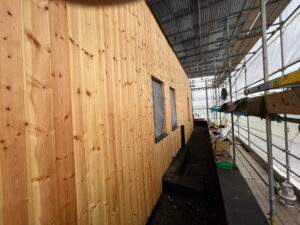
🔹 ASTM & UL (United States)
- ASTM E84 / UL 723 → Surface burning test (like BS 476 Part 7). Produces Flame Spread Index (FSI) and Smoke Developed Index (SDI).
- ASTM E119 / UL 263 → Fire resistance of structural elements (like BS 476 Parts 20–22). Rates walls, floors, and beams for hours of stability.
- UL 1709 → Hydrocarbon pool fire test, especially important in oil & gas industries.
🔹 ISO Standards (International)
- ISO 834 → Standard fire resistance test, the model for many national codes.
- ISO 5660 (Cone Calorimeter) → Measures heat release, smoke, and ignition behavior.
- Used as a neutral global reference where no local standard is specified.
🔹 Indian Standards (IS)
- IS 1641 / IS 1642 → Fire safety in buildings and non-combustibility.
- IS 3809 / IS 11817 → Fire resistance tests for structures.
- While IS codes exist, in practice most tenders in India refer directly to BS 476 or ASTM/UL, as these are internationally recognized.
Why This Matters for Customers
- A product tested under BS 476 is credible in India, Middle East, and Asia.
- For European projects, only EN 13501 evidence is valid.
- For US or oil & gas projects, ASTM/UL tests are mandatory.
- For global consultants, ISO provides a common language.
Ameetuff and BS 476 Compliance
At Ameetuff Technical Paints, fire protection is not just about products — it is about tested, trusted, and approved solutions. Every coating we supply is backed by government-recognized testing and certification so that consultants, contractors, and project owners can specify our systems with confidence.
🔹 Our Approvals and Testing
- All major coatings — structural steel, ducts, vermiculite systems, fire stop barriers — are tested as per BS 476 Parts 6, 7, 20–24.
- Testing and certification is carried out in CSIR-CBRI (Central Building Research Institute) and NABL-accredited laboratories, ensuring validity in Indian and international government projects.
- Independent approvals make Ameetuff coatings eligible for CPWD, metro rail, airport, refinery, defence, and data centre projects.
🔹 Performance Delivered
- Structural Steel Coatings: Provide up to 2–4 hours of fire resistance as per BS 476 Part 20/21.
- Duct Coatings (Silicon Epoxy & Water-Based): Tested as per BS 476 Part 24, with Type A & B resistance for 120–240 minutes.
- Fire Stop Barriers & Mortars: Certified to BS 476 Part 20, sealing cable and duct penetrations against fire spread.
- Surface Coatings (Fire-Retardant Paints, Fabrics, Wood): Tested for surface spread of flame and fire propagation as per BS 476 Parts 6 & 7.
🔹 Why Consultants and Clients Choose Us
- Proven in Critical Projects: New Parliament Building, PMO, Seabird Naval Base, metros, airports, refineries, and high-rise complexes.
- Recognized by Authorities: Backed by Government of India labs and approvals that withstand scrutiny in audits and tenders.
- Complete System Approach: From coatings to sealants, barriers, and primers, every solution is tested to perform as a system — not just as an isolated product.
Our Commitment:
At Ameetuff, we don’t just claim compliance — we prove it. Every fireproof coating we deliver is documented, tested, and approved to the highest standards, ensuring safety, performance, and peace of mind for our clients.

